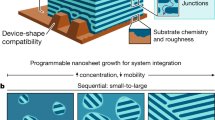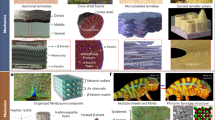Abstract
The inability to synthesize hierarchical structures with independently tailored nanoscale and mesoscale features limits the discovery of next-generation multifunctional materials. Here we present a predictable molecular self-assembly strategy to craft nanostructured materials with a variety of phase-in-phase hierarchical morphologies. The compositionally anisotropic building blocks employed in the assembly process are formed by multicomponent graft block copolymers containing sequence-defined side chains. The judicious design of various structural parameters in the graft block copolymers enables broadly tunable compositions, morphologies and lattice parameters across the nanoscale and mesoscale in the assembled structures. Our strategy introduces advanced design principles for the efficient creation of complex hierarchical structures and provides a facile synthetic platform to access nanomaterials with multiple precisely integrated functionalities.
This is a preview of subscription content, access via your institution
Access options
Access Nature and 54 other Nature Portfolio journals
Get Nature+, our best-value online-access subscription
$32.99 / 30 days
cancel any time
Subscribe to this journal
Receive 12 print issues and online access
$259.00 per year
only $21.58 per issue
Buy this article
- Purchase on SpringerLink
- Instant access to full article PDF
Prices may be subject to local taxes which are calculated during checkout




Similar content being viewed by others
Data availability
The data that support the findings of this study are available from the corresponding authors upon reasonable request. Source data are provided with this paper.
Code availability
The code generated during the current study is available from the corresponding authors upon reasonable request.
References
Garnier, F., Hajlaoui, R., Yassar, A. & Srivastava, P. All-polymer field-effect transistor realized by printing techniques. Science 265, 1684–1686 (1994).
Sirringhaus, H. et al. High-resolution inkjet printing of all-polymer transistor circuits. Science 290, 2123–2126 (2000).
Stoykovich, M. P. et al. Directed assembly of block copolymer blends into nonregular device-oriented structures. Science 308, 1442–1446 (2005).
Huo, F. et al. Polymer pen lithography. Science 321, 1658–1660 (2008).
Tumbleston, J. R. et al. Continuous liquid interface production of 3D objects. Science 347, 1349–1352 (2015).
Zeng, C., Chen, Y., Kirschbaum, K., Lambright, K. J. & Jin, R. Emergence of hierarchical structural complexities in nanoparticles and their assembly. Science 354, 1580–1584 (2016).
Feng, L., Wang, K.-Y., Willman, J. & Zhou, H.-C. Hierarchy in metal–organic frameworks. ACS Central Sci. 6, 359–367 (2020).
Lutz, J.-F., Lehn, J.-M., Meijer, E. W. & Matyjaszewski, K. From precision polymers to complex materials and systems. Nat. Rev. Mater. 1, 16024 (2016).
Li, C. et al. Supramolecular–covalent hybrid polymers for light-activated mechanical actuation. Nat. Mater. 19, 900–909 (2020).
Feng, X. et al. Single crystal texture by directed molecular self-assembly along dual axes. Nat. Mater. 18, 1235–1243 (2019).
Macfarlane, R. J., Jones, M. R., Lee, B., Auyeung, E. & Mirkin, C. A. Topotactic interconversion of nanoparticle superlattices. Science 341, 1222–1225 (2013).
Nagaoka, Y. et al. Superstructures generated from truncated tetrahedral quantum dots. Nature 561, 378–382 (2018).
Tian, Y. et al. Ordered three-dimensional nanomaterials using DNA-prescribed and valence-controlled material voxels. Nat. Mater. 19, 789–796 (2020).
Santos, P. J., Gabrys, P. A., Zornberg, L. Z., Lee, M. S. & Macfarlane, R. J. Macroscopic materials assembled from nanoparticle superlattices. Nature 591, 586–591 (2021).
Hudson, S. D. et al. Direct visualization of individual cylindrical and spherical supramolecular dendrimers. Science 278, 449–452 (1997).
Lee, S., Bluemle, M. J. & Bates, F. S. Discovery of a Frank-Kasper σ phase in sphere-forming block copolymer melts. Science 330, 349–353 (2010).
Bates, F. S. et al. Multiblock polymers: panacea or Pandora’s box? Science 336, 434–440 (2012).
Huang, M. et al. Selective assemblies of giant tetrahedra via precisely controlled positional interactions. Science 348, 424–428 (2015).
Bockstaller, M. R., Mickiewicz, R. A. & Thomas, E. L. Block copolymer nanocomposites: perspectives for tailored functional materials. Adv. Mater. 17, 1331–1349 (2005).
Aldaye, F. A., Palmer, A. L. & Sleiman, H. F. Assembling materials with DNA as the guide. Science 321, 1795–1799 (2008).
Zhao, Y. et al. Small-molecule-directed nanoparticle assembly towards stimuli-responsive nanocomposites. Nat. Mater. 8, 979–985 (2009).
Sanford, M. S., Love, J. A. & Grubbs, R. H. A versatile precursor for the synthesis of new ruthenium olefin metathesis catalysts. Organometallics 20, 5314–5318 (2001).
Xia, Y., Olsen, B. D., Kornfield, J. A. & Grubbs, R. H. Efficient synthesis of narrowly dispersed brush copolymers and study of their assemblies: the importance of side chain arrangement. J. Am. Chem. Soc. 131, 18525–18532 (2009).
Bolton, J., Bailey, T. S. & Rzayev, J. Large pore size nanoporous materials from the self-assembly of asymmetric bottlebrush block copolymers. Nano Lett. 11, 998–1001 (2011).
Chae, C.-G. et al. Experimental formulation of photonic crystal properties for hierarchically self-assembled POSS–bottlebrush block copolymers. Macromolecules 51, 3458–3466 (2018).
Fei, H.-F. et al. Influence of molecular architecture and chain flexibility on the phase map of polystyrene-block-poly(dimethylsiloxane) brush block copolymers. Macromolecules 52, 6449–6457 (2019).
Guo, Z. H. et al. Janus graft block copolymers: design of a polymer architecture for independently tuned nanostructures and polymer properties. Angew. Chem. Int. Ed. 57, 8493–8497 (2018).
Kawamoto, K. et al. Graft-through synthesis and assembly of Janus bottlebrush polymers from A-branch-B diblock macromonomers. J. Am. Chem. Soc. 138, 11501–11504 (2016).
Masuda, J. et al. Composition-dependent morphological transition of hierarchically-ordered structures formed by multiblock terpolymers. Macromolecules 40, 4023–4027 (2007).
Hayashida, K. et al. Hierarchical morphologies formed by ABC star-shaped terpolymers. Macromolecules 40, 3695–3699 (2007).
Markov, V., Kriksin, Y., Erukhimovich, I. & Brinke, G. T. Perpendicular lamellar-in-lamellar and other planar morphologies in A-b-(B-b-A)2-b-C and (B-b-A)2-b-C ternary multiblock copolymer melts. J. Chem. Phys. 139, 084906 (2013).
Ruokolainen, J., Brinke, G. T. & Ikkala, O. Supramolecular polymeric materials with hierarchical structure-within-structure morphologies. Adv. Mater. 11, 777–780 (1999).
Zhang, Z.-K. et al. Hierarchical structures with double lower disorder-to-order transition and closed-loop phase behaviors in charged block copolymers bearing long alkyl side groups. Macromolecules 53, 8714–8724 (2020).
Hofman, A. H., Terzic, I., Stuart, M. C. A., ten Brinke, G. & Loos, K. Hierarchical self-assembly of supramolecular double-comb triblock terpolymers. ACS Macro Lett. 7, 1168–1173 (2018).
Zhu, Y.-L. et al. GALAMOST: GPU-accelerated large-scale molecular simulation toolkit. J. Comput. Chem. 34, 2197–2211 (2013).
Hoogerbrugge, P. J. & Koelman, J. M. V. A. Simulating microscopic hydrodynamic phenomena with dissipative particle dynamics. Europhys. Lett. 19, 155–160 (1992).
Groot, R. D. & Warren, P. B. Dissipative particle dynamics: bridging the gap between atomistic and mesoscopic simulation. J. Chem. Phys. 107, 4423–4435 (1997).
Groot, R. D. & Madden, T. J. Dynamic simulation of diblock copolymer microphase separation. J. Chem. Phys. 108, 8713–8724 (1998).
Acknowledgements
M.Z. acknowledges support from the National Science Foundation (NSF; DMR-2003875). J.A.J. acknowledges support from Eni S.p.A. through the MIT Energy Initiative and an NSF award (CHE-1629358). C.O.O. acknowledges support from an NSF award (DMR-1945966). W.L. acknowledges support from the National Natural Science Foundation of China (21925301). X.F. thanks the China Scholarship Council (CSC no. 201706240130) for the financial support for his visit at Yale University. A.N.L. thanks the NSF Graduate Research Fellowship for supporting her research. The research used resources of the CMS beamline (11-BM) of the National Synchrotron Light Source II, a US Department of Energy Office of Science User Facility operated for the US Department of Energy Office of Science by Brookhaven National Laboratory under contract no. DE-SC0012704. We also thank R. Li (Brookhaven National Laboratory) and B. Q. Mercado (Yale) for their technical assistance with SAXS measurements during the COVID-19 pandemic.
Author information
Authors and Affiliations
Contributions
R.L., Y.X., X.F., J.A.J. and M.Z. designed the research. R.L., Y.X. and X.F. performed all synthetic work; R.L., Y.X., X.F., A.N.L, Z.S. and R.D. conducted the structure and property characterization; Q.S., Y.Q., Q.X. and W.L. conducted the DPD simulations; and R.L., Y.X., X.F. and M.Z. analysed the data. R.L., Y.X., X.F., A.N.L., C.O.O., J.A.J., W.L. and M.Z. wrote the paper.
Corresponding authors
Ethics declarations
Competing interests
The authors declare no competing interests.
Peer review
Peer review information
Nature Materials thanks the anonymous reviewers for their contribution to the peer review of this work.
Additional information
Publisher’s note Springer Nature remains neutral with regard to jurisdictional claims in published maps and institutional affiliations.
Supplementary information
Supplementary Information
Supplementary Figs. 1–157 and Tables 1–4.
Source data
Source Data Fig. 2
Raw SAXS data used in Fig. 2a.
Source Data Fig. 3
Raw SAXS data used in Fig. 3b,d.
Source Data Fig. 4
Raw SAXS data used in Fig. 4a–c.
Rights and permissions
Springer Nature or its licensor (e.g. a society or other partner) holds exclusive rights to this article under a publishing agreement with the author(s) or other rightsholder(s); author self-archiving of the accepted manuscript version of this article is solely governed by the terms of such publishing agreement and applicable law.
About this article
Cite this article
Liang, R., Xue, Y., Fu, X. et al. Hierarchically engineered nanostructures from compositionally anisotropic molecular building blocks. Nat. Mater. 21, 1434–1440 (2022). https://doi.org/10.1038/s41563-022-01393-0
Received:
Accepted:
Published:
Issue date:
DOI: https://doi.org/10.1038/s41563-022-01393-0
This article is cited by
-
Emergence of layered nanoscale mesh networks through intrinsic molecular confinement self-assembly
Nature Nanotechnology (2023)
-
Unconventional 2D Periodic Nanopatterns Based on Block Molecules
Chinese Journal of Polymer Science (2023)



